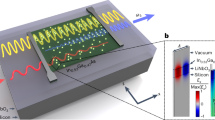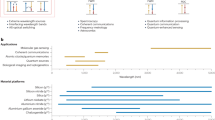Abstract
Nonlinear frequency mixing is a method to extend the wavelength range of optical sources with applications in quantum information and photonic signal processing. Lithium niobate with periodic poling is the most widely used material for frequency mixing due to its strong second-order nonlinear coefficient. The recent development using nanophotonic lithium niobate waveguides promises to improve nonlinear efficiencies by orders of magnitude thanks to subwavelength optical confinement. However, the intrinsic nanoscale inhomogeneity of nanophotonic lithium niobate waveguides limits the coherent interaction length, leading to low nonlinear efficiencies. Here we show improved second-order nonlinear efficiency in nanophotonic lithium niobate waveguides that breaks the limit imposed by nanoscale inhomogeneity. This is realized by developing the adapted poling approach to eliminate the impact of nanoscale inhomogeneity. We realize an overall second-harmonic efficiency of 104% W−1 (without cavity enhancement), approaching the theoretical performance for nanophotonic lithium niobate waveguides. The ideal square dependence of the nonlinear efficiency on the waveguide length is recovered. Phase-matching bandwidths and temperature tuneability are improved through dispersion engineering. We finally demonstrate a conversion ratio from pump to second-harmonic power greater than 80% in a single-pass configuration with pump power as low as 20 mW. Our work therefore breaks the trade-off between the conversion ratio and pump power, offering a potential solution for highly efficient and scalable nonlinear-optical sources, amplifiers and converters.
This is a preview of subscription content, access via your institution
Access options
Access Nature and 54 other Nature Portfolio journals
Get Nature+, our best-value online-access subscription
$29.99 / 30 days
cancel any time
Subscribe to this journal
Receive 12 print issues and online access
$259.00 per year
only $21.58 per issue
Buy this article
- Purchase on Springer Link
- Instant access to full article PDF
Prices may be subject to local taxes which are calculated during checkout




Similar content being viewed by others
Data availability
The data generated and/or analysed in this work are available from the corresponding author upon reasonable request.
References
Weis, R. & Gaylord, T. Lithium niobate: summary of physical properties and crystal structure. Appl. Phys. A 37, 191–203 (1985).
Schliesser, A., Picqué, N. & Hänsch, T. W. Mid-infrared frequency combs. Nat. Photonics 6, 440–449 (2012).
Ghimire, S. & Reis, D. A. High-harmonic generation from solids. Nat. Physics 15, 10–16 (2019).
Buryak, A. V., Di Trapani, P., Skryabin, D. V. & Trillo, S. Optical solitons due to quadratic nonlinearities: from basic physics to futuristic applications. Phys. Rep. 370, 63–235 (2002).
O’Brien, J. L., Furusawa, A. & Vučković, J. Photonic quantum technologies. Nat. Photonics 3, 687–695 (2009).
Wehner, S., Elkouss, D. & Hanson, R. Quantum internet: a vision for the road ahead. Science 362, 9288 (2018).
He, G. S. Optical phase conjugation: principles, techniques, and applications. Prog. Quantum Electron. 26, 131–191 (2002).
Cerullo, G. & De Silvestri, S. Ultrafast optical parametric amplifiers. Rev. Sci. Instrum. 74, 1–18 (2003).
Langrock, C., Kumar, S., McGeehan, J. E., Willner, A. & Fejer, M. All-optical signal processing using/spl chi//sup (2)/nonlinearities in guided-wave devices. J. Light. Technol. 24, 2579–2592 (2006).
Wooten, E. L. et al. A review of lithium niobate modulators for fiber-optic communications systems. IEEE J. Sel. Top. Quantum Electron. 6, 69–82 (2000).
Elshaari, A. W., Pernice, W., Srinivasan, K., Benson, O. & Zwiller, V. Hybrid integrated quantum photonic circuits. Nat. Photonics 14, 285–298 (2020).
Zhu, D. et al. Integrated photonics on thin-film lithium niobate. Adv. Opt. Photonics 13, 242–352 (2021).
Boes, A. et al. Lithium niobate photonics: unlocking the electromagnetic spectrum. Science 379, eabj4396 (2023).
Wang, C. et al. Integrated lithium niobate electro-optic modulators operating at cmos-compatible voltages. Nature 562, 101–104 (2018).
Xu, M. et al. High-performance coherent optical modulators based on thin-film lithium niobate platform. Nat. Commun. 11, 3911 (2020).
Li, M. et al. Lithium niobate photonic-crystal electro-optic modulator. Nat. Commun. 11, 4123 (2020).
Zhang, M. et al. Broadband electro-optic frequency comb generation in a lithium niobate microring resonator. Nature 568, 373–377 (2019).
Shah, M., Briggs, I., Chen, P.-K., Hou, S. & Fan, L. Visible-telecom tunable dual-band optical isolator based on dynamic modulation in thin-film lithium niobate. Opt. Lett. 48, 1978–1981 (2023).
Xu, Y. et al. Bidirectional interconversion of microwave and light with thin-film lithium niobate. Nat. Commun. 12, 4453 (2021).
Umeki, T., Tadanaga, O. & Asobe, M. Highly efficient wavelength converter using direct-bonded ppznln ridge waveguide. IEEE J. Quantum Electron. 46, 1206–1213 (2010).
Kashiwazaki, T. et al. Continuous-wave 6-db-squeezed light with 2.5-tHz-bandwidth from single-mode ppln waveguide. APL Photonics 5, 036104 (2020).
Parameswaran, K. R. et al. Highly efficient second-harmonic generation in buried waveguides formed by annealed and reverse proton exchange in periodically poled lithium niobate. Opt. Lett. 27, 179–181 (2002).
Parameswaran, K. R., Kurz, J. R., Roussev, R. V. & Fejer, M. M. Observation of 99% pump depletion in single-pass second-harmonic generation in a periodically poled lithium niobate waveguide. Opt. Lett. 27, 43–45 (2002).
Suntsov, S., Rüter, C. E., Brüske, D. & Kip, D. Watt-level 775 nm SHG with 70% conversion efficiency and 97% pump depletion in annealed/reverse proton exchanged diced PPLN ridge waveguides. Opt. Expr. 29, 11386–11393 (2021).
Cho, C.-Y. et al. Power scaling of continuous-wave second harmonic generation in a mgo: Ppln ridge waveguide and the application to a compact wavelength conversion module. Opt. Lett. 46, 2852–2855 (2021).
Berry, S. A., Carpenter, L. G., Gray, A. C., Smith, P. G. & Gawith, C. B. Zn-indiffused diced ridge waveguides in MGO: PPLN generating 1 watt 780 nm SHG at 70% efficiency. OSA Contin. 2, 3456–3464 (2019).
Carpenter, L. G. et al. Cw demonstration of shg spectral narrowing in a ppln waveguide generating 2.5 w at 780 nm. Opt. Express 28, 21382–21390 (2020).
Wang, C. et al. Ultrahigh-efficiency wavelength conversion in nanophotonic periodically poled lithium niobate waveguides. Optica 5, 1438–1441 (2018).
Rao, A. et al. Actively-monitored periodic-poling in thin-film lithium niobate photonic waveguides with ultrahigh nonlinear conversion efficiency of 4,600%W−1 cm−2. Opt. Express 27, 25920–25930 (2019).
Zhao, J. et al. Shallow-etched thin-film lithium niobate waveguides for highly-efficient second-harmonic generation. Opt. Express 28, 19669–19682 (2020).
Chen, P.-K., Briggs, I., Hou, S. & Fan, L. Ultra-broadband quadrature squeezing with thin-film lithium niobate nanophotonics. Opt. Lett. 47, 1506–1509 (2022).
Chang, L. et al. Thin film wavelength converters for photonic integrated circuits. Optica 3, 531–535 (2016).
Boes, A. et al. Improved second harmonic performance in periodically poled lnoi waveguides through engineering of lateral leakage. Opt. Express 27, 23919–23928 (2019).
Zhang, H., Li, Q., Zhu, H., Cai, L. & Hu, H. Second harmonic generation by quasi-phase matching in a lithium niobate thin film. Opt. Mater. Express 12, 2252–2259 (2022).
Lu, J. et al. Periodically poled thin-film lithium niobate microring resonators with a second-harmonic generation efficiency of 250,000%/W. Optica 6, 1455–1460 (2019).
Bruel, M. Silicon on insulator material technology. Electron. Lett. 31, 1201–12021 (1995).
Shoji, I., Kondo, T., Kitamoto, A., Shirane, M. & Ito, R. Absolute scale of second-order nonlinear-optical coefficients. JOSA B. 14, 2268–2294 (1997).
Helmfrid, S., Arvidsson, G. & Webjörn, J. Influence of various imperfections on the conversion efficiency of second-harmonic generation in quasi-phase-matching lithium niobate waveguides. JOSA B. 10, 222–229 (1993).
Cui, C., Zhang, L. & Fan, L. In situ control of effective Kerr nonlinearity with pockels integrated photonics. Nat. Phys. 18, 497–501 (2022).
Cui, C., Zhang, L. & Fan, L. Control spontaneous symmetry breaking of photonic chirality with reconfigurable anomalous nonlinearity. Preprint at arXiv https://arxiv.org/abs/2208.04866 (2022).
Acknowledgements
This work is supported in part by the US Department of Energy, Office of Advanced Scientific Computing Research (Field Work Proposal grant no. ERKJ355); Office of Naval Research (grant no. N00014-19-1-2190); NSF-ERC Center for Quantum Networks (grant no. EEC-1941583). The reactive ion ether used in this study was acquired through an NSF MRI grant (no. ECCS-1725571). Device fabrication was performed in the OSC cleanroom at the University of Arizona.
Author information
Authors and Affiliations
Contributions
P.-K.C. and L.F. conceived the experiment. P.-K.C. fabricated the device, performed the measurement, analysed the data and developed the simulation in useful discussion with C.C. and L.Z. P.-K.C. and I.B. optimized the poling condition. I.B. and M.S. optimized the fabrication procedure. P.-K.C. and L.F. wrote the manuscript. L.F. supervised the work.
Corresponding author
Ethics declarations
Competing interests
All information in this work is covered by a pending patent application (application number 63302331) filed by P.-K.C. and L.F. The other authors declare no competing interests.
Peer review
Peer review information
Nature Nanotechnology thanks Andy Boes, Wolfram Pernice and the other, anonymous, reviewer(s) for their contribution to the peer review of this work.
Additional information
Publisher’s note Springer Nature remains neutral with regard to jurisdictional claims in published maps and institutional affiliations.
Extended data
Extended Data Fig. 1 Device cross-section.
SEM image of the nanophotonic lithium niobate waveguide cross-section.
Extended Data Fig. 2 Simulated effective refractive index and poling period.
Simulated effective refractive index at wavelength 1550nm (a), 775nm (b), and poling periods (c) with different lithium niobate device thicknesses.
Extended Data Fig. 3 Temperature tunability.
Peak wavelengths of second-harmonic spectrum obtained in the 21-mm waveguide with adapted poling under different temperatures.
Extended Data Fig. 4 Dispersion engineering.
(a) Simulated group velocity mismatch, (b) temperature tuning dispersion value.
Rights and permissions
Springer Nature or its licensor (e.g. a society or other partner) holds exclusive rights to this article under a publishing agreement with the author(s) or other rightsholder(s); author self-archiving of the accepted manuscript version of this article is solely governed by the terms of such publishing agreement and applicable law.
About this article
Cite this article
Chen, PK., Briggs, I., Cui, C. et al. Adapted poling to break the nonlinear efficiency limit in nanophotonic lithium niobate waveguides. Nat. Nanotechnol. 19, 44–50 (2024). https://doi.org/10.1038/s41565-023-01525-w
Received:
Accepted:
Published:
Issue Date:
DOI: https://doi.org/10.1038/s41565-023-01525-w



